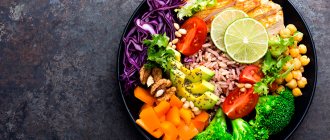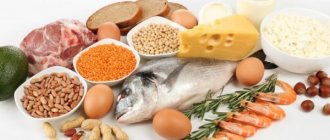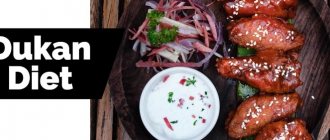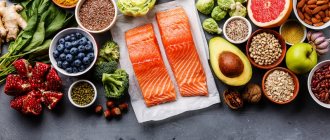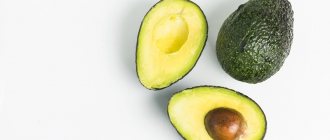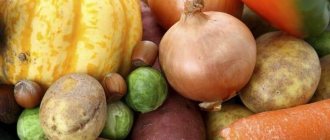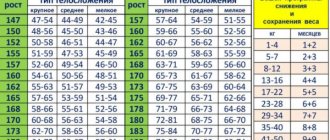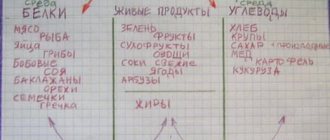In this article:
- The importance of proper nutrition
- 10 basic principles of proper nutrition
- Composition of the diet with proper nutrition
- Recommended foods for proper nutrition
- Foods to Avoid
- 3 tips for selecting and consuming products
- Sample weekly menu for men
- Sample weekly menu for women
- Calorie content of food
When talking about proper nutrition, you should not mean various diets for weight loss or special menus for athletes. It should be about food that is healthy. It would seem that nothing could be simpler: exclude all harmful foods from your diet and lean on healthy ones. However, not all so simple.
It’s not enough to give up snacking on the go, addiction to fast food and alcohol abuse. You need to follow a certain diet, monitor the balance of substances entering the body, and sometimes even count calories. Yes, it's not easy. But the result will be one you can only dream of.
The importance of proper nutrition
Everything that the human body needs for life comes into it along with food and water. Quality life indicators such as a person’s health status, physical and emotional activity, ability to work, and life expectancy depend on the composition and properties of the food consumed. Perhaps no other factors are as important for the body.
Experts say that 50% of it is lifestyle (and with it nutrition, the products consumed) that influences a person’s physical condition. Another 20% depend on hereditary factors and living conditions. And only 10% remains on this list for the quality of medical care.
It is proper and healthy nutrition that allows the body to function normally. With food, a person receives the energy necessary for life. Due to the beneficial substances supplied with food, new cells are built, tissues and organs are renewed. Lack of food or its excess is always harmful, both for young and old people.
What does this mean? Physical and mental development is inhibited, a person quickly gets tired, feels general weakness, is unable to work normally and resist external negative influences.
The transition to the principles of proper nutrition is vital for those who:
- feels that it’s time to get rid of extra pounds;
- chooses a healthy lifestyle (healthy lifestyle system);
- loves sports and takes care of his physical fitness;
- understands that poor nutrition is the cause of many diseases;
- is no longer completely healthy (heart disease, digestive problems, etc.) precisely because of poor nutrition, and therefore you have to stick to a diet;
- tries to instill proper nutritional culture in her family.
Practice shows that most often people remember proper nutrition specifically for weight loss. Overweight is observed in 54% of Russian men and 59% of women, these are the statistics. And in most cases, the problem is precisely that people are accustomed to poor nutrition and lifestyle. They consume a lot of high-calorie foods and exercise little. What is the result? Not only does a fat person not look very attractive, he also feels bad, because all organs have to withstand increased stress.
As for the very essence of proper nutrition, there are quite a lot of different opinions about this, as well as those aspects that should be taken into account. Below we will outline general principles that almost anyone can follow, although, of course, there are always exceptions to the rules. Some people may have to give up some foods completely. After some time, with experience, you will understand which diet is optimal for you.
What meat is suitable for weight loss and proper nutrition?
The first step is to give up fatty varieties of pork and beef .
Rabbit meat, if anything, is the most dietary meat. Rabbit is not only valuable fur, but also 20% of protein, which is so necessary for the construction of muscle cells. And at the same time, eared meat contains only 5% fat and almost no cholesterol, as well as allergens. Plus - tender rabbit meat is tender because it is perfectly absorbed in our body.
Next on our list is poultry . Chicken fillet is the best option. The so-called white meat is the most useful part of the bird carcass. There is simply a storehouse of B vitamins and protein. Larger amounts of these beneficial substances are found in seafood. But more on that another time.
Also, do not forget that when eating white chicken meat, you must remove the skin from it.
turkey meat is also great - it is also considered dietary.
Another type of meat included in the dietary list is veal. It also has a minimum of fat and a maximum of protein. Veal should be cooked in its own juices in a steamer or on the grill, although you can bake it in foil and a sleeve to preserve the maximum of the nutrients contained in the meat.
Let's sum up the intermediate results. What kind of meat can you eat while losing weight? Rabbit, white meat chicken or turkey without skin and veal.
Composition of the diet with proper nutrition
The rules of nutrition for every day are quite simple: a person must receive 6 important nutrients for life with food, namely proteins, fats, carbohydrates, useful minerals, a set of essential vitamins and water. The absence of any of them will negatively affect your health. Which food products contain the beneficial substances listed above?
- Protein-Rich Foods
Protein acts as a building material for the body's cells and supplies it with amino acids. Remember, you should not overuse foods rich in protein, but its lack is also harmful. The most protein is found in meat, fish, seafood, eggs, greens, soy, and legumes. The best time to consume animal proteins is in the morning, and leave plant-based ones for the evening.
- Sources of carbohydrates
Carbohydrates provide energy and are a source of nutrition for brain cells, so you cannot do without them. Unless you can reduce your consumption if you decide to lose weight. Healthy, so-called slow carbohydrates are found in vegetables, fruits, legumes, pasta and cereals, as well as in wheat grains (but specifically in durum varieties).
- Fat-containing products
One of the conditions for proper nutrition is the obligatory consumption of fat, although many mistakenly believe that this is not so. Fats are building materials for the body, support normal thermoregulation, and give a person endurance. But they are not burned so easily because of their inertia. The approximate consumption rate for humans is 25% of vegetable fats, and 75% of animal fats. The most fats are found in meat, fish, nuts and vegetable oils.
- Sources of vitamins
Vitamins are essential for the normal functioning of many vital systems of the human body, immune, hormonal, visual organs and others. Lack of vitamins causes vitamin deficiency, which then becomes the cause of dangerous diseases. Vegetables, fruits, herbs, berries and cereal sprouts, caviar, fish oil, brewer's yeast are rich in vitamins.
- Foods High in Minerals
Minerals mean salts, salt ions and useful low-molecular substances. Even a small amount of them gives the body everything it needs for its normal functioning. For example, calcium ions are responsible for bone strength, and iron is required to maintain the required level of hemoglobin. The most minerals are found in vegetables and fruits, meat, fish and seafood, also in salt, cereals, pasta, dairy products and bread.
- An important element of proper nutrition is water.
It is vital for a person along with the beneficial substances listed above. Water helps flush out toxins, helps digestion, and normalizes thermoregulation. The recommended amount of consumption for an adult is approximately 2-2.5 liters per day, and the loss of 7% of the fluid available in the body is already critical for health.
Stage two: the second five simple steps to PP
It is necessary to learn how to correctly select and distribute products throughout the day.
Consume complex carbohydrates
A common misconception among people trying to lose weight is that carbohydrates contribute to the accumulation of excess weight. In fact, carbohydrates are an important element for the functioning of the body. They saturate the human body with energy and give a good mood.
Carbohydrates can be complex or simple. Complex carbohydrates take a long time to break down without causing a sharp jump in sugar.
While it is worth minimizing simple carbohydrates, because they are the ones that quickly break down, increase the sugar content, which drops sharply and causes a feeling of hunger. You have to eat food, and unspent simple carbohydrates begin to be stored in fat reserves.
Foods containing complex carbohydrates:
- Cereals;
- Durum pasta;
- Vegetables;
- Legumes;
- Black bread;
- Fruits.
Foods containing simple carbohydrates:
- Sweets;
- Baking.
It is worth minimizing the consumption of honey, white rice and sweet fruits.
Change your approach to cooking
Be sure to exclude foods cooked in oils from your diet. Fried foods increase cholesterol levels and increase the risk of cardiovascular disease.
There are many alternative ways of cooking: stewing, boiling, using ovens. Perhaps frying food is one of the most harmful cooking methods. It is difficult to break the habit of eating fried foods. At the first stages of addiction, you can use natural seasonings to improve taste if it is impossible to eat lean food.
Fiber is the main weight loss aid. A large amount of it is found in plant foods. When thermally processing products, it is destroyed. The solution is to minimize food exposure to high temperatures. Give preference to raw vegetables and fruits. If cooking cannot be avoided, try not to overcook the vegetables.
Properly distribute proteins, carbohydrates and fats throughout the day
Try to distribute products correctly to achieve maximum weight loss effect.
Basic rules for creating a menu:
- Breakfast - complex carbohydrates. The optimal solution is to take cereals.
- Lunch: complex carbohydrates, white meat and vegetables. Stew with salad is perfect.
- Dinner: poultry, fish, eggs. Reduce your carbohydrate intake in the evening by adding more protein. Carbohydrates are necessary for energy, proteins are necessary for the regeneration of cells and tissues.
Increase physical activity
A sedentary lifestyle is a common cause of poor health. From a medical point of view, minimal or small amounts of physical activity contribute to a decrease in bone mass, muscle atrophy, decreased endurance, and deterioration of the joints and spine.
Form a habit: exercise daily. You don't have to spend hours at the gym. Do what you like: yoga, dancing, cycling, running, sports games.
The main condition is that physical activity should be enjoyable. For example, home workouts can last 10-20 minutes. Agree, it won’t take that much time, especially if you can combine the exercises with watching your favorite movie.
For people who are overweight, it is better to devote time to walking. By playing sports, you can feel a daily surge of strength and energy.
Remove stress and lack of sleep
Successful weight loss results are difficult to achieve with lack of sleep and bad mood. Cortisol, produced when there is a lack of sleep, slows down the breakdown of fat cells. High levels of cortisol affect the slow achievement of positive weight loss results. Cortisol affects the accumulation of fat cells.
The content of this hormone in the blood increases due to stress and consumption of caffeine-containing drinks. To lower your cortisol levels, try to reduce your anxiety and alertness.
The process of switching to PP seems to many to be difficult and even unlikely in principle. But by following these small gradual steps, you can still significantly correct your poor diet and lifestyle.
Recommended foods for proper nutrition
With proper nutrition, the menu must contain healthy foods every day, containing a lot of fiber, vitamins, minerals, amino acids, fatty acids, micro and macroelements. Typically these are foods that are quickly digested, promote good metabolism and are very healthy. Here is an approximate list of them:
- Berries, vegetables, fruits (fresh, rich in fiber and vitamin C).
- Cereals, including in the form of porridges (contain magnesium, potassium, folic acid, vitamins B, E).
- Dried nuts and fruits (rich in protein, vitamins, fatty acids).
- Poultry meat. It contains a lot of protein, amino acids, vitamins A, B, E.
- Various varieties of fish, seafood (sources of protein, phosphorus, calcium, polyunsaturated acids, vitamins D, E, B12).
- Fermented milk products, namely cottage cheese, sour cream, yogurt (contain a lot of calcium, protein, carbohydrates, amino acids, plus vitamins D, A, B12).
- Green tea is rich in polyphenols, as well as minerals and vitamins.
- Cold-pressed vegetable oil (they contain a lot of phospholipids, vitamins A, D, E, linoleic acid and other polyunsaturated acids).
- Bread (cereal) is rich in fiber, amino acids and enzymes.
- A very useful product is honey. It contains many vitamins and microelements, fructose, glucose, phytoncides and fast carbohydrates.
Proper healthy eating just means including the products listed above in your diet (of course, in reasonable quantities and combinations). Nutritionist advice: cereals (cooked in water) go well with vegetable salads; it is better to use olive oil as a dressing. You should not chop both tomatoes and cucumbers into one salad. The former are rich in vitamin C, and the latter, when cut, release an enzyme that has a destructive effect on this vitamin. The best addition to meat, poultry and fish are vegetables such as cabbage, zucchini, cucumbers, asparagus, and radishes. Fruits should not be combined with other foods, but it is better to consume them either before or an hour after the main meal.
For adults
A healthy diet includes the following components:
- Fruits, vegetables, legumes (eg, lentils, beans), nuts, and whole grains (eg, unprocessed corn, millet, oats, wheat, and brown rice).
- At least 400g (that is, five servings) of fruits and vegetables per day (2), excluding potatoes, sweet potatoes, cassava and other starchy root vegetables.
- Free sugars should make up less than 10% of total energy intake (2, 7), which is equivalent to 50 g (or 12 level teaspoons) for a normal weight person consuming about 2000 calories per day, but ideally to provide additional health benefits, they should account for less than 5% of total energy intake (7). Free sugars are all sugars added to foods or beverages by the manufacturer, cook or consumer, as well as sugars naturally present in honey, syrups, fruit juices and their concentrates.
- Fats should make up less than 30% of total energy intake (1, 2, 3). It is necessary to give preference to unsaturated fats (found in fish, avocados and nuts, as well as sunflower, soybean, canola and olive oils) as opposed to saturated fats (found in fatty meats, butter, palm and coconut oils, cream, cheese, ghee). and lard) and trans fats of all types, including both industrially produced trans fats (found in baked and fried foods, pre-packaged snack foods and other foods such as frozen pizzas, pies, cookies, waffles, cooking oils and sandwich mixes) and trans fats naturally occurring (contained in meat and dairy products obtained from ruminant animals such as cows, sheep, goats and camels). It is recommended to reduce saturated fat intake to less than 10% and trans fat to less than 1% of total energy intake (5). You should especially avoid consuming industrially produced trans fats, which are not part of a healthy diet (4, 6).
- Consume less than 5 g of salt (equivalent to about one teaspoon) per day (8). Salt must be iodized.
Foods to Avoid
If you decide to adhere to the principles of proper nutrition, then remember that there are also harmful foods that interfere with normal metabolism and contribute to the accumulation of harmful fats.
Here's what you should remove from your diet:
- alcohol;
- nuts with salt, chips, crackers, puffed corn;
- everything sweet;
- baked goods, especially with a lot of sugar;
- semi-finished products and concentrated products such as instant mashed potatoes, “quick” noodles, etc.;
- everything fried;
- sausage, smoked products;
- any factory-produced sauces (mayonnaise too);
- fast food dishes;
- soda and factory-made juices (you can drink freshly squeezed).
It would also be good to stop consuming salt and sugar. This is not so simple, but at least add a little salt to your dishes, and try replacing sugar with honey. We can recommend using sea salt or pink Himalayan salt. Firstly, due to greater saturation with useful components, and secondly, due to a smaller amount of sodium chloride.
Prohibited foods for PP
As you already know, proper nutrition is not based on strict prohibitions and restrictions, however, if you want to lose weight and improve your health, then the list of foods prohibited on the diet will help you with this. What products are we talking about?
- Fatty meats: pork, lamb
- Sausages
- Cheese with a high percentage of fat content - 60%-70% fat content: blue, processed, Camembert, hard varieties.
- Pasta not made from durum wheat
- Bakery products made from white flour
- Confectionery: cakes, pastries
- Ready-made breakfast cereals
- Instant soups and purees, instant noodles
- Canned food and semi-finished products
- Instant oat flakes
- Mayonnaise and other white sauces
- Chips, croutons
- Chocolate bars
How is PP different from a diet?
Sample weekly menu for men
So, the menu is in accordance with the norms of proper nutrition for a week for men.
Monday:
- Breakfast: boiled egg (1 pc.), buckwheat porridge, vegetable salad, green tea.
- Second breakfast: kefir (1 glass) or banana (1 pc.).
- Lunch: meat (boiled), vegetable salad, fruit or berry compote.
- Afternoon snack: green tea, grain bread or baked goods (dietary).
- Dinner: fish (boiled or baked), vegetable salad, green tea with a spoon of honey.
Tuesday:
- Breakfast: oatmeal porridge with berries and pumpkin seeds, a glass of tea or compote.
- Second breakfast: vegetable or beet salad, bread.
- Lunch: chicken meat (boiled), buckwheat porridge, vegetable salad, tea (green).
- Afternoon snack: a piece of bread (whole grain) with cheese, compote.
- Dinner: meat (boiled), potatoes (also boiled), fresh vegetables.
Wednesday:
- Breakfast: omelet with green onions and dill, a glass of tea or compote.
- Second breakfast: any fruit or nuts.
- Lunch: cutlet (steamed), vegetable side dish, cream soup, glass of tea (green) or compote.
- Afternoon snack: cottage cheese casserole (dietary), tea.
- Dinner: a piece of fish (lean, baked or boiled), vegetable salad, compote.
Thursday:
- Breakfast: scrambled eggs or omelet with asparagus, vegetables (stewed), tea with honey.
- Second breakfast: banana (1 piece) or nuts.
- Lunch: boiled meat (low-fat), potatoes (bake or boil), vegetables (fresh), a glass of green tea or compote.
- Afternoon snack: a piece of bread (whole grain) with cheese, cottage cheese or feta cheese (add berries), a glass of tea.
- Dinner: meat (boiled) or steamed cutlet, vegetables, a glass of tea.
Friday:
- Breakfast: pearl barley porridge (with milk) with nuts.
- Second breakfast: fruits or berries.
- Lunch: lean turkey or chicken, vegetable soup, tea.
- Afternoon snack: bread, a glass of tea (green) or compote.
- Dinner: vegetable salad, fish (stewed), a glass of compote or plain water.
Saturday:
- Breakfast: oatmeal porridge, any berries or fruits, tea (can be sweet).
- Second breakfast: one grapefruit.
- Lunch: cutlet (steamed), buckwheat porridge, cream soup (vegetables), compote.
- Afternoon snack: cookies (dietary only), glass of tea.
- Dinner: a piece of meat (lean, boiled), any vegetables, a glass of green tea.
Sunday:
- Breakfast: porridge with raisins or any dried fruits, tea (can be sweet).
- Second breakfast: banana (1 pc.).
- Lunch: chicken (boiled), any side dish, tea.
- Afternoon snack: bread, a glass of milk or kefir.
- Dinner: chicken (boiled), side dish - vegetables (fresh), compote.
Practical tips for maintaining a healthy diet
Fruits and vegetables
Eating at least 400g, or five servings, of fruits and vegetables every day reduces the risk of developing NCDs (2) and helps ensure your daily fiber intake.
Fruit and vegetable consumption can be improved. To do this you need:
- always include vegetables in your diet;
- eat fresh fruits and vegetables as snacks;
- consume seasonal fruits and vegetables; And
- consume a variety of fruits and vegetables.
Fats
Reducing total fat intake to less than 30% of total energy intake helps prevent unhealthy weight gain in adults (1, 2, 3). In addition, the risk of developing NCDs can be reduced by:
- reducing saturated fat intake to less than 10% of total energy intake;
- reducing trans fat intake to less than 1% of total energy intake; And
- replacing saturated fats and trans fats with unsaturated fats (2, 3), in particular polyunsaturated fats.
Fat intake, especially saturated fat and industrially produced trans fat, can be reduced in the following ways:
- steam or boil food rather than fry or bake;
- replace butter, lard and ghee with vegetable oils rich in polyunsaturated fats, such as soybean, canola (canola), corn, safflower and sunflower oil;
- Eat reduced-fat dairy products and lean meats or trim visible fat from meat; And
- Limit your consumption of baked and fried foods, as well as pre-prepared snack foods and other foods (such as donuts, muffins, pies, cookies, and waffles) that contain industrially produced trans fats.
Salt, sodium and potassium
Many people consume too much sodium from salt (equivalent to an average intake of 9-12 grams of salt per day) and not enough potassium (less than 3.5 grams). High sodium intake and insufficient potassium intake contribute to high blood pressure, which in turn increases the risk of heart disease and stroke (8, 11).
Reducing salt intake to recommended levels of less than 5 g per day could help prevent 1.7 million deaths per year (12).
People often don't know how much salt they consume. In many countries, the majority of salt intake comes from processed foods (prepared meals; processed meats such as bacon, ham and salami; cheese; and salty snacks) or from foods that are often consumed in large quantities (such as bread). Salt is also added to food during cooking (for example, by adding broth, bouillon cubes, soy sauce, and fish sauce) or during eating (by adding table salt).
Salt intake can be reduced in the following ways:
- Limit the amount of salt and high-sodium seasonings (such as soy sauce, fish sauce, and stock) added when cooking;
- do not place salt or sauces high in sodium on the table;
- limit your intake of salty snacks; And
- choose foods low in sodium.
Some food manufacturers reformulate their products to reduce sodium content, and labels should be checked for sodium content before purchasing or consuming products. Potassium may mitigate the negative effects of excess sodium intake on blood pressure. Potassium intake can be increased by consuming fresh fruits and vegetables.
Sahara
Sugar intake in both adults and children should be reduced to less than 10% of total energy intake (2, 7). Reducing intake to less than 5% of total energy intake will provide additional health benefits (7).
Consumption of free sugars increases the risk of developing dental caries. Excess calories from foods and drinks that contain free sugars also contribute to unhealthy weight gain, which can lead to overweight and obesity. Recent evidence suggests that free sugars have effects on blood pressure and serum lipids. This suggests that reducing the intake of free sugars helps reduce the risk of developing cardiovascular disease (13).
Sugar intake can be reduced in the following ways:
- limit consumption of foods and drinks high in sugars, such as sugary snacks, candy and sweetened drinks (that is, all types of drinks containing free sugars, which include carbonated and non-carbonated soft drinks, fruit and vegetable juices and drinks, liquid and powder concentrates , flavored waters, energy and sports drinks, ready-made teas, ready-made coffees and flavored milk drinks); And
- Replace sugary snacks with fresh fruits and vegetables.
Sample weekly menu for women
Now the menu is in accordance with the norms of proper nutrition for a week for women.
Monday:
- Breakfast: oatmeal porridge with fruits or berries, tea (green).
- Second breakfast: one apple.
- Lunch: fish (boiled) with a side dish of rice and fresh vegetables, a glass of compote.
- Afternoon snack: lean chicken meat (breast) with vegetables (steamed).
- Dinner: cottage cheese (with low fat content), a glass of green tea.
Tuesday:
- Breakfast: oatmeal porridge with berries and pumpkin seeds, a glass of tea or compote.
- Second breakfast: cottage cheese with honey (one spoon).
- Lunch: chicken broth, vegetable salad, tea (green).
- Afternoon snack: any fruit.
- Dinner: lean chicken (boiled), fresh tomatoes.
Wednesday:
- Breakfast: oatmeal porridge with berries or fruits, a glass of tea or compote.
- Second breakfast: oranges (2 pcs.).
- Lunch: vegetables with chicken breast (stewed), tea (green) or compote.
- Afternoon snack: cottage cheese casserole (dietary), glass of tea.
- Dinner: cottage cheese (low-fat only), compote.
Thursday:
- Breakfast: rolled oatmeal milk porridge with berries, tea.
- Second breakfast: yogurt (only natural, without any additives).
- Lunch: fish and potato soup.
- Afternoon snack: vegetable salad (fresh vegetables), seasoned with sour cream.
- Dinner: lean chicken (breast), fresh cucumbers (2 pcs.), a glass of tea.
Friday:
- Breakfast: potatoes (boiled), one egg, cucumber (fresh, 1 pc.).
- Second breakfast: one kiwi, unsweetened tea.
- Lunch: mushroom soup with rice, a piece of hard cheese.
- Afternoon snack: cottage cheese casserole with berries.
- Dinner: fish (stewed) with seaweed, a glass of compote or plain water.
Saturday:
- Breakfast: omelet, tea without sugar.
- Second breakfast: one apple, a glass of kefir.
- Lunch: a piece of fish (boiled), rice, compote.
- Afternoon snack: shrimp, vegetables (fresh).
- Dinner: cottage cheese (low fat only).
Sunday:
- Breakfast: oatmeal porridge with raisins or any dried fruits, tea.
- Second breakfast: one banana, one orange.
- Lunch: chicken (boiled), vegetable casserole, glass of tea.
- Afternoon snack: fresh tomatoes, shrimp (boiled).
- Dinner: fish cutlets (steamed), boiled brown rice, vegetables (fresh), compote.
What should dinner be like? Recipes for every day
Dinner should be kept light. It is worth giving up carbohydrates and fats altogether, eating only protein foods along with vegetables or dairy products.
Example recipes:
- Pie with cottage cheese and herbs.
- Mix 200g of cottage cheese with an egg and 40g of cheese, add herbs.
- Place half of the dough on a plate, cover with cheese and add the 2nd part, and cover with cheese again. Cook in the oven.
- Goulash with zucchini pasta.
- Finely chop the veal and simmer with carrots and onions. Add salt and 1 tbsp. flour.
- Chop the zucchini using a Korean carrot peeler.
- Cook in boiling water for 3-5 minutes.
Calorie content of food
In order to competently organize proper nutrition at home, it is important to be able to calculate the calorie content of the dishes included in the menu, as well as learn to create a diet balanced in the content of proteins, fats and carbohydrates, that is, to maintain the so-called BJU balance. Only then will a person receive exactly the amount of energy and nutrients he needs to feel good, not feel hungry and maintain a normal weight.
Here you also need to know the permissible calorie intake per day, plus take into account your lifestyle. Athletes require more energy, which means the calorie content of food consumed should be higher. And completely different standards, for example, for office workers or those who spend a lot of time at home.
The recommended amount of calories consumed per day for men is 2000-2400 kcal, for women – 1800-2400 kcal (taking into account age and lifestyle). The ratio of proteins, fats and carbohydrates has already been mentioned above, it should be something like this:
- 30-40% of all food consumed is proteins;
- 40-50% - carbohydrates;
- 20-25% - fats.
There are special formulas for individual calculation of calorie content of food. This, for example, is the so-called WHO formula, which takes into account the surface area of the human body, and to carry out calculations using the Ketch-McArdle formula, you need to know the percentage of fat in the body. You can easily create a diet for the week, adhering to the principles of proper nutrition, if you know your indicators.
To summarize, we can say that proper nutrition is not a myth, but a completely achievable reality. The main thing is to set goals for yourself and confidently move towards them. And we are not talking about a strict diet here. The point is to give your body only natural and healthy foods that are not only tasty, but also incredibly healthy.
Spices and seasonings for meat when losing weight
When losing weight, dietary meat can be cooked without salt. In this case, it is better to add to it:
- Bay leaf.
- Onion.
- Carrot.
- Peppercorns.
Cooked meat can be sprinkled with:
- Lemon juice.
- Apple juice.
- Soy sauce.
Maintain balance in your menu. Per 1 kg of body weight, the amount of protein should be plus or minus 1 g . Avoid eating fatty and high-calorie foods. Proper meat must be cooked correctly. Also, meals should be taken at the same time.
Plus, don’t forget to move, do exercises, and especially don’t lie around doing nothing. We ate deliciously and ran to shake everything so that it could be better absorbed.
Stop torturing yourself!
- We will develop a personal nutrition program for you.
- With it you will achieve your ideal weight without fasting or physical activity.
- This is the only truly healthy and natural way to lose weight.

